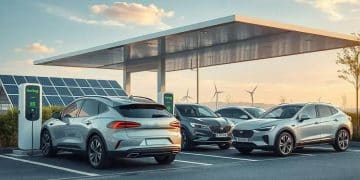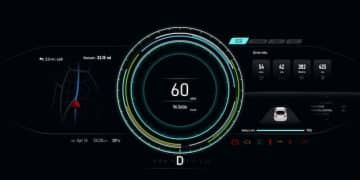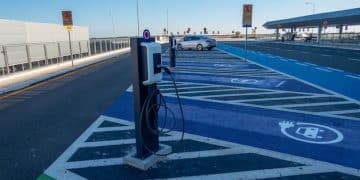Electric Vehicle Home Charging: Solutions & Efficiency Tips
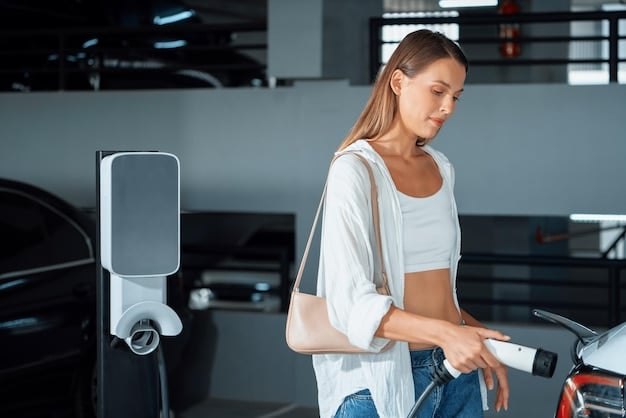
Electric vehicle home charging offers practical solutions like installing Level 2 chargers and optimizing charging schedules to maximize efficiency and convenience for EV owners.
Ready to charge your electric vehicle at home efficiently? This article explores practical solutions for electric vehicle home charging: practical solutions for installation and maximizing efficiency, ensuring you get the most out of your EV.
Understanding the Basics of Electric Vehicle Home Charging
Electric vehicle (EV) home charging is becoming increasingly popular as more people switch to electric cars. Understanding the basics of home charging can help you make informed decisions and optimize your charging setup. It involves knowing the different charging levels, the equipment required, and how to install it safely.
Charging Levels Explained
There are three primary levels of EV charging: Level 1, Level 2, and DC Fast Charging. Each level offers different charging speeds and requires specific equipment.
- Level 1 Charging: This is the slowest charging method, using a standard 120V household outlet. It’s convenient but adds only about 3-5 miles of range per hour.
- Level 2 Charging: This method uses a 240V outlet, similar to those used for dryers and ovens. It significantly increases charging speed, adding about 20-30 miles of range per hour.
- DC Fast Charging: While primarily used at public charging stations, DC Fast Charging is the fastest method, adding 60-80 miles of range in just 20 minutes. It’s generally not available for home use due to high power requirements.
Essential Equipment for Home Charging
To set up home charging, you’ll need certain equipment, including a charging unit (also known as an Electric Vehicle Supply Equipment or EVSE) and the necessary electrical connections. The specific equipment depends on the charging level you choose.
- Level 1 Charging: Typically, all you need is the charging cord that comes with your EV. Plug it into a standard household outlet.
- Level 2 Charging: Requires a Level 2 charging unit, which can be either wall-mounted or portable. You’ll also need a 240V outlet installed by a qualified electrician.
Understanding these basics helps you select the right equipment and prepare your home for efficient EV charging.
In summary, grasping the basics of EV home charging involves knowing the distinctions between charging levels and the equipment necessary for each. This knowledge is crucial for making informed decisions about your home charging setup.
Assessing Your Home’s Electrical Capacity
Before installing an EV charger, it’s essential to assess your home’s electrical capacity to ensure your system can handle the additional load. This involves checking your electrical panel, understanding your current energy consumption, and determining if upgrades are necessary.
Checking Your Electrical Panel
The electrical panel is the heart of your home’s electrical system. It distributes power to different circuits and protects against overloads. To assess your panel, locate it (usually in the garage, basement, or utility room) and check its amperage rating. This rating indicates the total amount of electricity your panel can safely handle.
Consider these points:
- Amperage Rating: Most homes have a 100-amp, 150-amp, or 200-amp panel. You can find the rating labeled on the main breaker.
- Available Capacity: Determine how much of your panel’s capacity is currently in use. Add up the amperage of all the breakers in use.
Ensuring you have enough available capacity is crucial for safely installing an EV charger.
Understanding Your Home’s Energy Consumption
Next, evaluate your home’s current energy consumption. This helps determine if adding an EV charger will overload your electrical system. Review your past electricity bills to understand your average monthly usage.
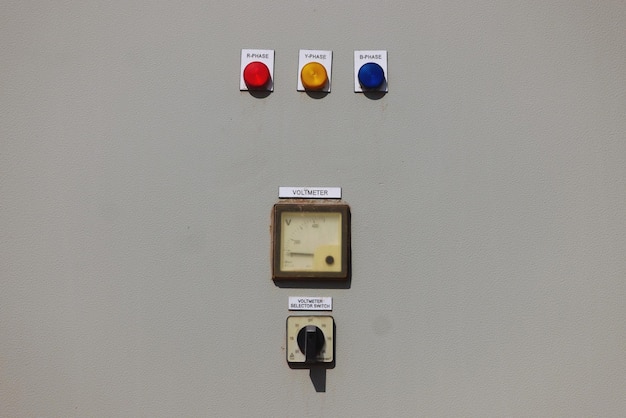
Key steps include:
- Reviewing Electricity Bills: Check your bills for kilowatt-hour (kWh) usage. This provides a baseline for your energy consumption.
- Peak Usage Times: Identify when your household consumes the most electricity, such as during evenings when appliances and lights are in use.
Knowing your energy consumption patterns is vital in planning for EV charging.
Determining the Need for Electrical Upgrades
Based on your panel’s capacity and energy consumption, you might need electrical upgrades. This could involve upgrading your electrical panel, installing a new circuit, or both.
Common upgrades include:
- Panel Upgrade: If your current panel doesn’t have enough capacity, consider upgrading to a higher amperage panel.
- Dedicated Circuit: Install a dedicated 240V circuit specifically for the EV charger to prevent overloading existing circuits.
Assessing your home’s electrical capacity is a critical step to ensure safe and efficient charging.
In conclusion, assessing your home’s electrical capacity involves examining the electrical panel, understanding energy consumption, and identifying necessary upgrades. These steps ensure that adding an EV charger won’t overload your electrical system, promoting safety and efficiency.
Choosing the Right Level 2 Charger
Selecting the right Level 2 charger is important for fast and efficient home charging. Key factors include considering charging speed, features like smart capabilities, and ensuring the charger is compatible with your EV. This section guides you through the process of choosing the best charger for your needs.
Factors to Consider When Selecting a Charger
Several factors should influence your choice of a Level 2 charger. Consider charging speed, smart features, safety certifications, and compatibility with your EV model.
- Charging Speed: Level 2 chargers offer different amperage levels, affecting charging speed. Higher amperage chargers provide faster charging.
- Smart Features: Some chargers offer Wi-Fi connectivity, smartphone apps, and scheduling options. These features can enhance convenience and help manage energy usage.
- Safety Certifications: Look for chargers with certifications from reputable organizations like UL or ETL, ensuring they meet safety standards.
Considering these factors helps you make an informed decision.
Top Level 2 Chargers on the Market
Several Level 2 chargers are highly rated by EV owners. Researching top brands and models can provide insights into performance, reliability, and user satisfaction. Some popular chargers include:
- JuiceBox: Known for its smart features and Wi-Fi connectivity.
- ChargePoint Home Flex: Offers adjustable amperage and a user-friendly app.
- Tesla Wall Connector: Designed for Tesla vehicles but compatible with other EVs using an adapter.
These chargers provide fast charging and useful features for EV owners.
Installation Considerations for Level 2 Chargers
Installing a Level 2 charger requires careful planning and might need a professional electrician. Choose the ideal location, considering factors like proximity to your electrical panel and protection from the elements.
- Location: Install the charger in a convenient location, typically in your garage or driveway. Ensure it’s protected from weather.
- Professional Installation: Hiring a qualified electrician ensures the charger is safely and correctly installed.
- Permits: Check local building codes and obtain any required permits before installation.
Correct installation ensures the charger operates safely and efficiently.
In summary, selecting the right Level 2 charger involves considering factors like charging speed and smart features, researching top models, and planning for proper installation. These steps optimize your home charging experience.
Optimizing Your Charging Schedule
Optimizing your charging schedule can save money and reduce strain on the electrical grid. Time-of-use rates, smart charging features, and maximizing overnight charging can significantly improve your charging efficiency.
Understanding Time-of-Use Rates
Many utility companies offer time-of-use (TOU) rates, which vary depending on the time of day. Charging during off-peak hours can result in lower electricity costs. Check with your utility provider for TOU rate options.
Key points to consider:
- Peak Hours: These are times when electricity demand is high, typically during the day. Avoid charging during these hours.
- Off-Peak Hours: These are times when demand is low, often overnight. Charging during these hours can save you money.
- Mid-Peak Hours: Some utilities also have mid-peak hours with moderate rates. Planning your charging around these rates helps optimize costs.
Understanding TOU rates can lead to significant savings.
Leveraging Smart Charging Features
Smart chargers offer features like scheduling, demand response, and energy monitoring. These capabilities allow you to automate your charging and optimize energy usage.
Key features include:
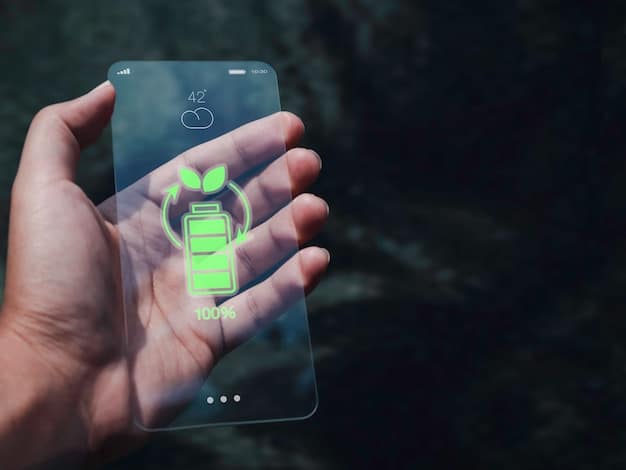
- Scheduling: Set your charger to operate only during off-peak hours, even if you plug in your EV earlier.
- Demand Response: Participate in utility programs that offer incentives for reducing energy use during peak demand.
- Energy Monitoring: Track your charging habits to identify areas for improvement and cost savings.
Using smart charging features enhances efficiency and reduces costs.
Maximizing Overnight Charging
Overnight charging is often the most convenient and cost-effective method. Electricity rates are typically lower overnight, and your EV can fully charge while you sleep.
Tips for maximizing overnight charging:
- Plug in Regularly: Make it a habit to plug in your EV every night, regardless of the current charge level.
- Set a Schedule: Use smart charging features to ensure charging occurs during off-peak hours.
- Monitor Charging Progress: Check your EV’s charging status in the morning to ensure it’s ready for your daily commute.
Maximizing overnight charging leverages off-peak rates and ensures your EV is always ready to go.
In conclusion, optimizing your charging schedule involves understanding time-of-use rates, leveraging smart charging features, and maximizing overnight charging. These strategies help save money and reduce strain on the grid.
Understanding Tax Credits and Incentives
Tax credits and incentives can significantly reduce the cost of installing an EV charger. Federal, state, and local programs offer financial assistance to encourage EV adoption. Understanding these incentives can make home charging more affordable.
Federal Tax Credits for EV Chargers
The federal government offers tax credits for the purchase and installation of EV chargers. These credits can help offset the initial costs of setting up home charging.
Key details about federal tax credits:
- Eligibility: Homeowners, renters, and businesses are often eligible for the federal tax credit.
- Credit Amount: The credit can cover a percentage of the cost of the charger and installation fees, up to a certain limit.
- Requirements: Specific requirements must be met to qualify for the credit, such as purchasing a charger that meets certain energy efficiency standards.
Checking federal tax credit options can lead to significant savings.
State and Local Incentives
Many states and local governments offer additional incentives for EV chargers. These can include rebates, grants, and tax credits. Researching these programs can provide further financial assistance.
Examples of state and local incentives:
- Rebates: Some states offer rebates for purchasing and installing EV chargers.
- Grants: Local governments sometimes provide grants to support EV infrastructure development.
- Tax Credits: States may offer additional tax credits on top of the federal credit.
Be sure to check what incentives are available in your area.
How to Claim Tax Credits and Incentives
Claiming tax credits and incentives involves following specific procedures and providing the necessary documentation. This might include filling out tax forms, submitting receipts, and providing proof of purchase and installation.
Steps to claim incentives:
- Research Eligibility: Ensure you meet all eligibility requirements for the tax credit or incentive.
- Gather Documentation: Collect receipts, invoices, and any other required documents.
- Follow Instructions: Follow the instructions provided by the IRS or your state/local government for claiming the incentive.
Taking the necessary steps ensures you receive the financial benefits you’re entitled to.
In conclusion, understanding tax credits and incentives is essential for reducing the cost of EV home charging. Federal, state, and local programs offer financial assistance, making it more affordable to install a charger. Claiming these incentives involves research, documentation, and following specific procedures.
Ensuring Safety and Compliance
Safety and compliance are crucial when installing and using an EV charger at home. Adhering to electrical codes, obtaining the necessary permits, and performing regular maintenance ensures a safe and reliable charging setup.
Adhering to Electrical Codes
Electrical codes are designed to protect homes and occupants from electrical hazards. Following these codes during EV charger installation is essential. Consult with a qualified electrician to ensure compliance.
Key aspects of electrical codes:
- Wiring Standards: Ensure wiring meets the required gauge and insulation standards.
- Grounding: Proper grounding is crucial to prevent electrical shocks.
- Circuit Protection: Use appropriate circuit breakers or fuses to prevent overloads.
Adhering to these codes ensures the safety of your electrical system.
Obtaining Necessary Permits
Many local jurisdictions require permits for electrical work, including EV charger installations. Obtaining the necessary permits ensures the installation meets local safety standards.
Steps to obtain permits:
- Check Local Requirements: Contact your local building department to determine if a permit is required.
- Submit Application: Fill out and submit the permit application with the required documentation.
- Schedule Inspection: After installation, schedule an inspection to ensure the work meets code requirements.
Obtaining permits verifies that your installation is safe and compliant.
Regular Maintenance and Inspections
Regular maintenance and inspections help identify and address potential issues before they become serious problems. Conducting routine checks and inspections ensures your EV charger is functioning safely and efficiently.
Maintenance tips:
- Visual Inspections: Regularly check the charger and wiring for any signs of damage or wear.
- Testing: Periodically test the charger to ensure it’s functioning correctly.
- Professional Inspections: Schedule professional inspections to identify any hidden issues.
Regular maintenance ensures the longevity and safety of your charging system.
In summary, ensuring safety and compliance involves adhering to electrical codes, obtaining necessary permits, and performing regular maintenance and inspections. These steps guarantee a safe and reliable EV charging setup at home.
| Key Point | Brief Description |
|---|---|
| ⚡ Charging Basics | Understand Level 1, Level 2, and DC Fast Charging for efficient EV charging. |
| 💡 Electrical Capacity | Assess your home’s electrical system and upgrade if needed for safe charging. |
| 💰 Incentives | Explore federal, state, and local incentives to reduce installation costs. |
| 📅 Optimized Schedule | Use time-of-use rates and smart features to save money on charging. |
Frequently Asked Questions (FAQ)
▼
Level 2 charging utilizes a 240V outlet, similar to those used for appliances like dryers. It adds approximately 20-30 miles of range per hour, providing a faster charging solution compared to Level 1.
▼
Many local jurisdictions require permits for EV charger installations. Contact your local building department to verify the requirements in your area. Obtaining a permit ensures the installation meets local safety standards.
▼
To save money, charge during off-peak hours when electricity rates are lower. Utilize smart charging features to schedule charging and monitor energy usage. Check with your utility provider for time-of-use rates.
▼
It is generally not recommended to use an extension cord for EV charging due to potential safety risks. Extension cords may not handle the high amperage required for EV charging. If needed, use a heavy-duty, appropriately rated cord.
▼
The federal government and many states offer tax credits or incentives for EV charger installation. Check the IRS website and your state’s energy office for current programs and eligibility requirements. These can significantly reduce costs.
Conclusion
By understanding the basics, assessing your home’s electrical capacity, choosing the right equipment, optimizing your charging schedule, and ensuring safety and compliance, you can efficiently and effectively charge your electric vehicle at home. Embracing these practices not only saves you money but also contributes to a more sustainable future.
